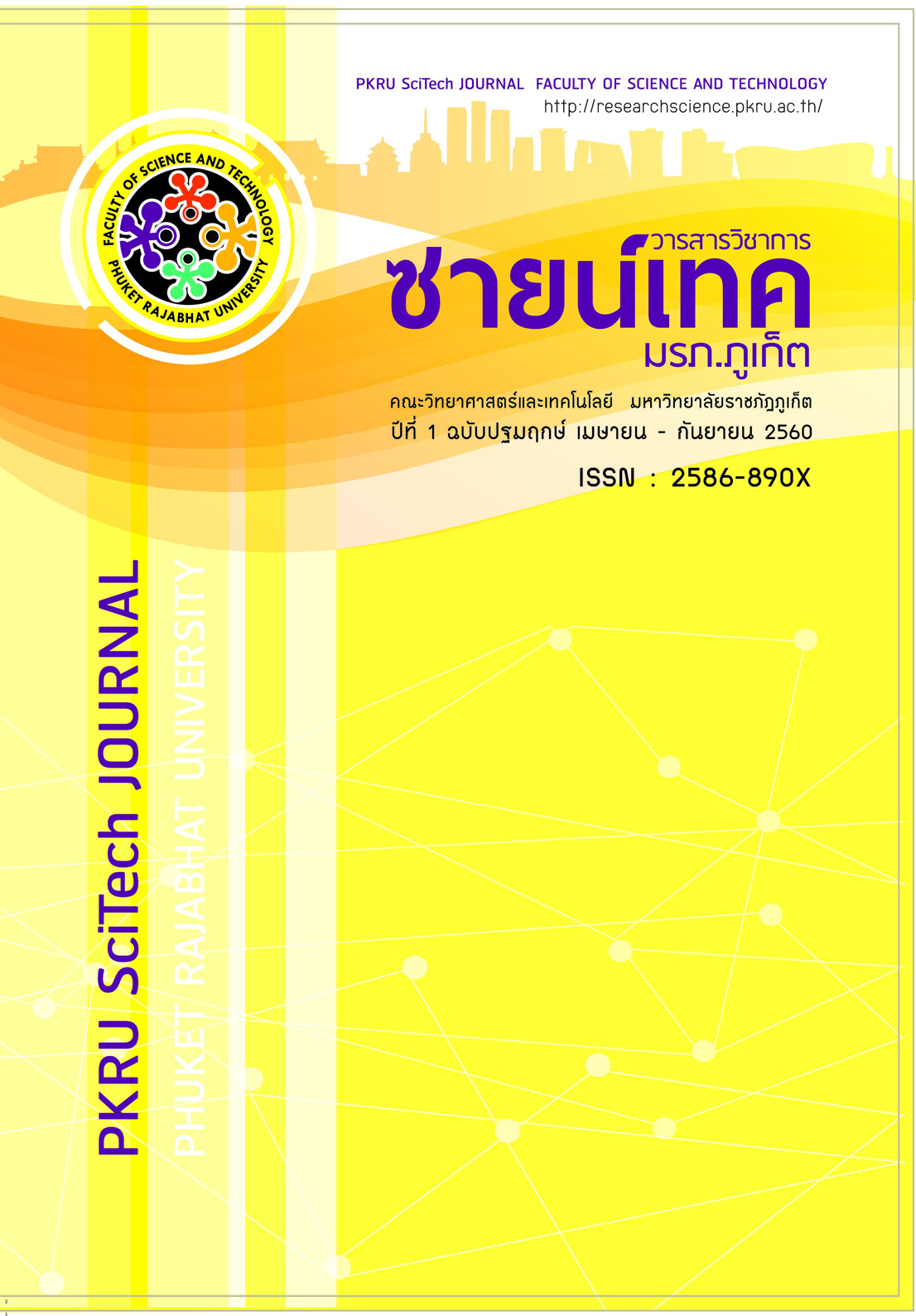การแยกระดับท้องไข่ในเมล็ดข้าวโดยการส่องผ่านของแสงเลเซอร์
Main Article Content
Abstract
ปัจจุบันสภาวะโลกส่งผลกระทบโดยตรงต่อการเกิดท้องไข่ในเมล็ดข้าวซึ่งเป็นตัวกำหนดราคาและคุณภาพข้าวในท้องตลาด จึงทำให้นักวิจัยข้าวต้องศึกษาระดับท้องไข่ในเมล็ดข้าวอย่างละเอียดมากขึ้น จำเป็นต้องใช้แรงงานคนในการคัดแยกระดับท้องไข่ของเมล็ดข้าวที่ได้จากแปลงทดลองภายในศูนย์วิจัยข้าว การวิจัยครั้งนี้มีวัตถุประสงค์เพื่อทดลองใช้แสงเลเซอร์สีแดงที่ความยาวคลื่น 632 นาโนเมตรมาส่องผ่านเมล็ดข้าวที่ได้จากศูนย์วิจัยข้าวปทุมธานี แล้วทำการศึกษาการส่องผ่านของแสงเลเซอร์ โดยการบันทึกภาพด้วยกล้อง CCD Camera ที่ถูกติดตั้งไว้กับกล้องจุลทรรศน์ คุณสมบัติของแสงดังกล่าวจะทำให้ภาพมีตำแหน่งมืด และสว่างไม่เท่ากัน ซึ่งสามารถใช้โปรแกรม MATLAB เบื้องต้นในการคำนวณหาพื้นที่ของการส่องผ่านแสงจากภาพที่บันทึกได้ เพื่อแยกระดับท้องไข่ให้เป็นไปอย่างแม่นยำ
Article Details
How to Cite
อินทรทัต ว. (2018). การแยกระดับท้องไข่ในเมล็ดข้าวโดยการส่องผ่านของแสงเลเซอร์. PKRU SciTech Journal, 1(1), 31–37. retrieved from https://ph01.tci-thaijo.org/index.php/pkruscitech/article/view/156648
Section
Research Articles
- The original content that appears in this journal is the responsibility of the author excluding any typographical errors.
- The copyright of manuscripts that published in PKRU SciTech Journal is owned by PKRU SciTech Journal.
References
[1] Inouchi, N., Ando, H., Asaoka, M., Okuno, K., & Fuwa, H. (2000). The Effect of Environmental Temperature on Distribution of Unit Chains of Rice Amylopectin. Starch/Stärke, 52, 8 - 12.
[2] Kim, S.S., Lee, S.E., Kim, O.W., & Kim, D.C. (2000). Physicochemical Characteristics of Chalky Kernels and Their Effects on Sensory Quality of Cooked Rice. American Association of Cereal Chemists, Inc. 77, 376 – 379.
[3] Cheng, F.M., Zhong, L.J., Wang, F., & Zhang, G.P. (2004). Differences in cooking and eating properties between chalky and translucent parts in rice grains. Food Chemistry, 90, 39 – 46.
[4] Peng, S., Huang, J., Sheehy, J.E., Laza, R.C., Visperas, R.M., Zhong, X., Centeno, G.S., Khush, G.S., & Cassman, K.G. (2004). Rice yields decline with higher night temperature from global warming. PNAS, 101, 9971 - 9975.
[5] Yamakawa, H., Hirose, T., Kuroda, M., & Yamaguchi, T. (2007). Comprehensive Expression Profiling of Rice Grain Filling-Related Genes under High Temperature Using DNA Microarray. American Society of Plant Biologists, 144, 258 – 277.
[6] Yoshioka, Y., Iwata, H., Tabata, M., Ninomiya, S. & Ohsawa, R. (2007). Chalkiness in Rice: Potential for Evaluation with Image Analysis. CROP SCIENCE, 47, 2113 - 2120.
[7] Jinorose, M., Pracha-yawarakorn, S., & Soponronnarit, S. (2010). Development of a Computer Vision System and Novel Evaluation Criteria to Characterize Color and Appearance of Rice. Drying Technology, 28, 1118 – 1124.
[8] Sun, C., Liu, T., Ji, C., Jiang, M., Tian, T., Guo, D., Wang, L., Chen, Y., & Liang, X. (2014). Evaluation and analysis the chalkiness of connected rice kernels based on image processing technology and support vector machine. Journal of Cereal Science, 60, 426 - 432.
[9] Lin, Z., Zhang, X., Yang, X., Li, G., Tang, S., Wang, S., Ding, Y., & Liu, Z. (2014). Proteomic analysis of proteins related to rice grain chalkiness using iTRAQ and a novel comparison system based on a notched-belly mutant with white-belly. Lin et al. BMC Plant Biology, 14, 1471 - 2229.
[10] ศูนย์เมล็ดพันธุ์ข้าวขอนแก่น. (2559). ข่าวสารเมล็ดพันธุ์ข้าว, 121, 1.
[11] สมาคมผู้ส่งออกข้าวไทย. (2559). ข่าวสมาคมผู้ส่งออกข้าวไทย, 1 - 4.
[2] Kim, S.S., Lee, S.E., Kim, O.W., & Kim, D.C. (2000). Physicochemical Characteristics of Chalky Kernels and Their Effects on Sensory Quality of Cooked Rice. American Association of Cereal Chemists, Inc. 77, 376 – 379.
[3] Cheng, F.M., Zhong, L.J., Wang, F., & Zhang, G.P. (2004). Differences in cooking and eating properties between chalky and translucent parts in rice grains. Food Chemistry, 90, 39 – 46.
[4] Peng, S., Huang, J., Sheehy, J.E., Laza, R.C., Visperas, R.M., Zhong, X., Centeno, G.S., Khush, G.S., & Cassman, K.G. (2004). Rice yields decline with higher night temperature from global warming. PNAS, 101, 9971 - 9975.
[5] Yamakawa, H., Hirose, T., Kuroda, M., & Yamaguchi, T. (2007). Comprehensive Expression Profiling of Rice Grain Filling-Related Genes under High Temperature Using DNA Microarray. American Society of Plant Biologists, 144, 258 – 277.
[6] Yoshioka, Y., Iwata, H., Tabata, M., Ninomiya, S. & Ohsawa, R. (2007). Chalkiness in Rice: Potential for Evaluation with Image Analysis. CROP SCIENCE, 47, 2113 - 2120.
[7] Jinorose, M., Pracha-yawarakorn, S., & Soponronnarit, S. (2010). Development of a Computer Vision System and Novel Evaluation Criteria to Characterize Color and Appearance of Rice. Drying Technology, 28, 1118 – 1124.
[8] Sun, C., Liu, T., Ji, C., Jiang, M., Tian, T., Guo, D., Wang, L., Chen, Y., & Liang, X. (2014). Evaluation and analysis the chalkiness of connected rice kernels based on image processing technology and support vector machine. Journal of Cereal Science, 60, 426 - 432.
[9] Lin, Z., Zhang, X., Yang, X., Li, G., Tang, S., Wang, S., Ding, Y., & Liu, Z. (2014). Proteomic analysis of proteins related to rice grain chalkiness using iTRAQ and a novel comparison system based on a notched-belly mutant with white-belly. Lin et al. BMC Plant Biology, 14, 1471 - 2229.
[10] ศูนย์เมล็ดพันธุ์ข้าวขอนแก่น. (2559). ข่าวสารเมล็ดพันธุ์ข้าว, 121, 1.
[11] สมาคมผู้ส่งออกข้าวไทย. (2559). ข่าวสมาคมผู้ส่งออกข้าวไทย, 1 - 4.


